2020.10.17
Two days were devoted to the theme Climate, risks and energies:What are the stakes, what assets for the Alpine territories in post-crisis management? on 30 September and 1 October, in Chamonix, in the Alps. 150 actors (representatives of territories - elected representatives and services -, governmental and European institutions, research actors, consultancy firms, associative actors, energy agencies, private companies, clusters, energy operators) met at the Le Majestic Congress Centre, part of which was connected remotely, in very suitable conditions.
Organised by the French Presidency of the European Union Strategy for the Alpine Region (EUSALP), in partnership with AURA-EE, the Regions of Auvergne-Rhône-Alpes, Bourgogne-Franche-Comté, Provence-Alpes-Côte d'Azur and CasaClima, this event highlighted the experience of Alpine territories. These territories are particularly vulnerable due to their extreme geo-sociological characteristics, which have always been able to develop natural risk management strategies, energy strategies and today a necessary adaptation to climate change.
As coordinator of the Alpine Territories Network for Integrated Natural Risk Management (TAGIRN) in the French Alpine massif and member of the EUSALP Action Group 8, mandated by ANCT, PARN (Pôle Alpins des Risques Naturels) also participated in the elaboration of the programme and the animation of the conference.
In his opening message, Éric Fournier, as mayor of Chamonix, testified to the challenges to be met in his own territory, citing European tools such as AdaPT Mont-Blanc: an Interreg Alcotra project which aims to develop territorial planning and management tools for adaptation to climate change that can be integrated and adopted by public institutions at different levels, local and regional. Christiane Barret, general delegate of the French presidency of EUSALP, for her part, highlighted existing cooperation projects in the Alpine region, in particular ALPGRIDS, for the creation of local energy loops and the development of self-consumption. Finally, Elise Beck, professor-researcher at the PACTE Laboratory of the University of Grenoble Alpes, gave a presentation entitled: "From a fashionable concept to its operationalisation: social science insights on the resilience of territories".
Round tables focused on means and tools
A first round table was devoted to the needs and means necessary to fight against climate change and adaptation, with the participation of Frédérique Colas, Vice-President of the Burgundy-Franche-Comté Region, Laurence Boetti Forestier, Regional Councillor of the Provence-Alpes-Côte d'Azur Region, Éric Fournier, Vice-President of the Auvergne-Rhône-Alpes Region, Stefan Benzing, from the Baden Würtenberget International Cooperation Cécile Hanoune from DG CLIMA.
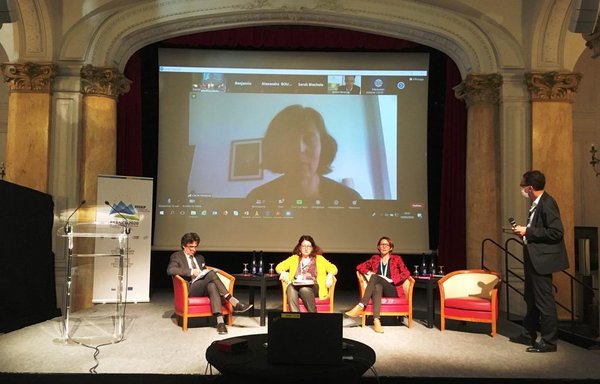
A second round table focused on the tools developed to manage crises, tools to reduce vulnerabilities, reduce dependency on fossil fuels, increase the energy autonomy of territories, reduce exposure to risk (TEPOS/GIRN, territorial governance, relocation, place left to nature). With the participation of Cédric Petitjean, Director General of the Cantonal Energy Office of the Canton of Geneva, Silvia Mezzano from the Hydrography Office of the Autonomous Region of Valle d'Aosta and Madeleine Rohrer, town councillor of the city of Merano.
Workshops to express needs, understand issues and initiate projects
In the afternoon, four workshops were offered: Adapt your territory to climate change! co-organised by AURA-EE and PARN. With the playful learning support ClimaSTORY developed by AURA-EE, the participants of this workshop were put in situation through a role play, around the map of a fictitious territory, in order to find solutions for adaptation to climate change.
Hydrogen, an energy vector in the making in the Alps? co-organised by AURA-EE, CasaClima and the Auvergne-Rhône-Alpes Region. The SUERA action groups wished to set up a working group " Green Hydrogen for the Alps " to develop the production and consumption of green hydrogen, develop infrastructures, stimulate the market and initiate cooperation. This initiative aims to develop Alpine cooperation projects and this first meeting provided the opportunity to present three project ideas.
An integrated approach in territorial planning, co-organised by PARN: presentation of pilot initiatives and discussions on cooperation perspectives to share good practices of integrated risk management in cities and metropolises of the Alpine Region, which represent poles of competence, research and innovation.
What are the energy-climate objectives for EUSALP, co-organised by AURA-EE, the Alpine Convention and EURAC, on the energy-climate objectives 2030 for SUERA, to be defined within the framework of the Green New Deal, and the need to build an Alpine energy observatory to monitor these objectives and stimulate the energy transition in the Alps
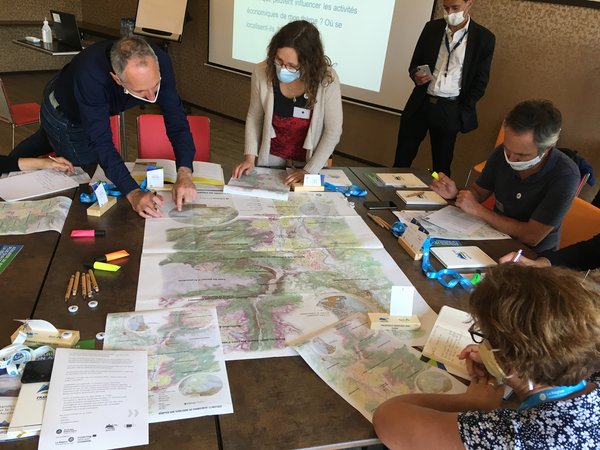
The day ended with the restitution of the thematic workshops and a word of conclusion by Serge Nocodie, president of Auvergne-Rhône-Alpes Energie Environnement (AURA-EE), vice-president of FEDARENE in charge of climate.
Field visits to concretely illustrate the issues raised
Two excursions were organised the next day. This was an opportunity for the participants to create links, discuss, exchange but also to become familiar with issues specific to mountain territories: territories "of excellence" that have acquired experience in managing issues at the crossroads between climate, risks and energy.
The visit to the micro-hydroelectric power plant, located at the foot of the Taconnaz glacier, was commented by elected officials from the two communities concerned, in the middle of which the Taconnaz stream flows (Chamonix and Les Houches) and Voltalia, the company managing the micro-hydro power plant located on the Taconnaz stream. A visit that highlighted the constraints linked to the production of renewable energy in urban alpine environments, and the means put in place in terms of risk management and prevention.
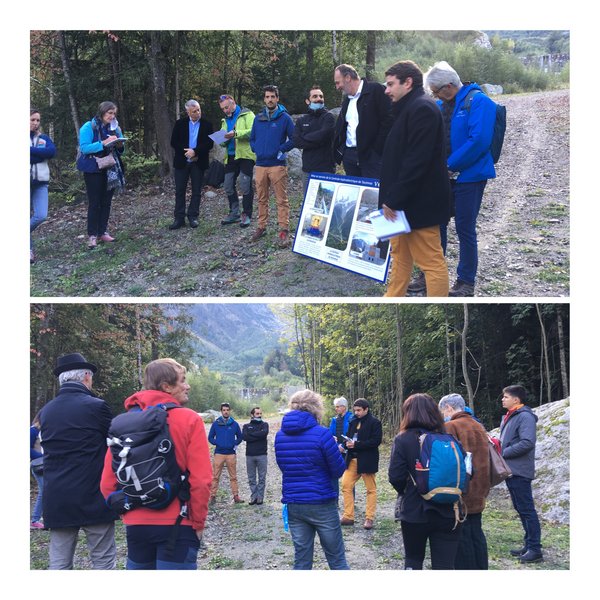
Another excursion: a three-hour hike to the Plan de l'Aiguille (altitude 2317m), located in the Mont Blanc massif. Led by Irène Alvarez and Brad Carlson, from CREA (Centre de recherche sur les écosystèmes d'altitude) with the intervention of Benjamin Einhorn, from PARN, this outing took the fifty or so participants to discover the impacts of climate change on fauna and flora, and their management through biodiversity. Among them was the Secretary of State for Biodiversity, Bérangère Abba, who later declared on her Twitter account: "It is in the heart of the Mont Blanc Massif that we become aware of its exceptional beauty but also of its extreme fragility". Shortly afterwards, the Secretary of State went to the Haute-Savoie prefecture, in Annecy, for the signature of the Mont Blanc decree, aimed at reconciling uses and practices, while preserving the environment.
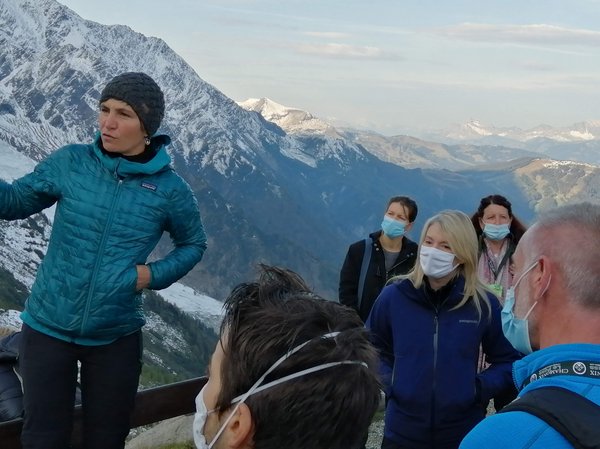
In the end, this event will have provided food for thought, drawn up recommendations and initiated cooperation projects in favour of adaptation to climate change, sustainable energy and the limitation of natural risks in the territories of the macro-Alpine region, which will be submitted to the European Commission. It will also have represented a privileged moment of meetings which, thanks to the health protocol, allowed the 70 participants present to meet, exchange and co-construct.
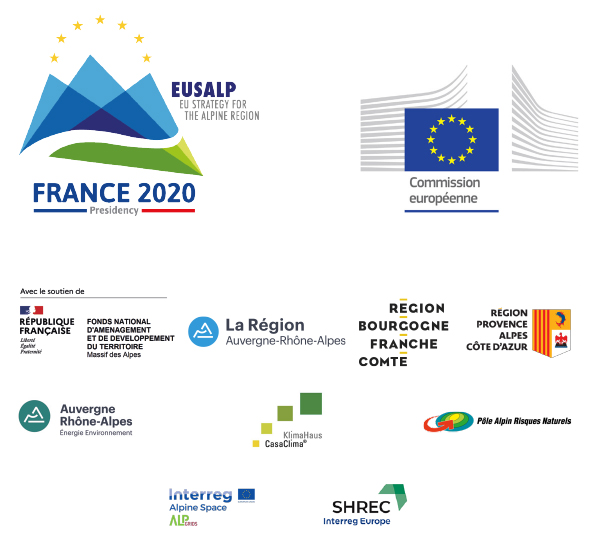


Imprimer